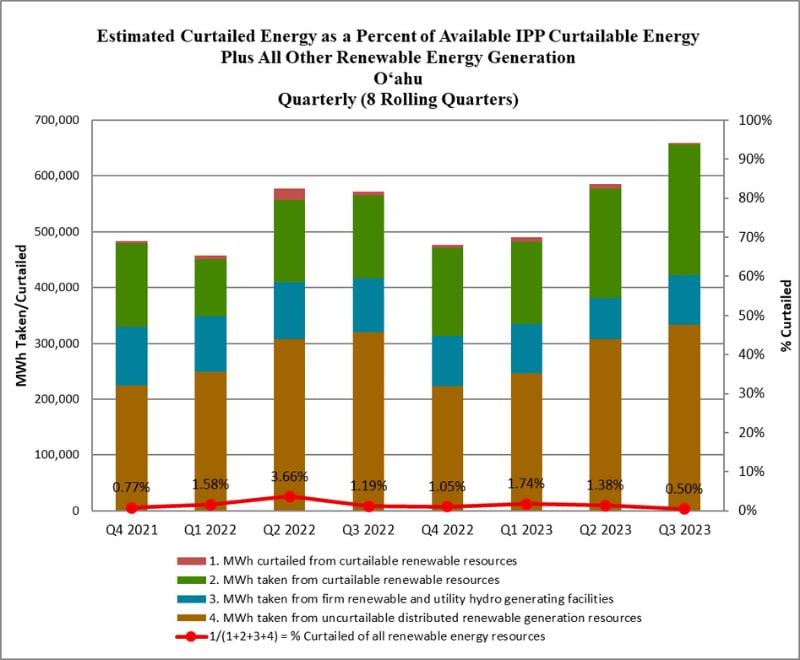Hawaii Installs Tesla Battery Storage for Critical Grid Support
An advanced 565 MWh battery storage facility featuring 185 MW of Tesla Megapacks will provide critical load shifting and frequency response services for Hawaii’s renewable energy transition.
A 185 MW/565 MWh battery energy storage system (BESS) recently started operating in Oahu, Hawaii, providing balancing services to support the island’s growing share of solar generation. Stakeholders behind the Kapolei Energy Storage (KES) project call it the world’s most advanced BESS, featuring 158 shipping container-sized Tesla Megapack 2 XL lithium iron phosphate (LFP) batteries across 8 acres of industrial-zoned land.
Battery storage containers at the Kapolei Energy Storage project in Hawaii. Image used courtesy of Plus Power
The grid-scale resource allows the state’s main utility, Hawaiian Electric, to respond to changing conditions throughout Oahu’s isolated island grid. The BESS eliminates the need for combustion-based peaker plants and performs black start functions to support blackout recovery. Its synthetic inertia feature mimics the power-smoothing capabilities of a rotating mechanical turbine. With 50 MW/25 MWh of additional frequency response control, it reacts to grid changes in just 250 milliseconds—faster than conventional combustion plants.
KES was developed by Texas-based Plus Power, which has several similarly-sized projects in transmission queues across the U.S. The battery system interconnects to Hawaiian Electric’s grid at an existing substation about 2,500 feet from the site. This required building a new transmission line adjacent to lines entering the 138 kV substation.
Tesla Megapacks offer several grid support features for utilities. Image used courtesy of Tesla
The site features rows of Tesla Megapack inverters. Tesla’s LFP batteries stand out from conventional lithium-ion chemistry because the cathode (lithium ferro-phosphate) is much cheaper than cobalt- or nickel-based materials. Even though this trade-off comes with a lower energy density, LFP’s cost and safety benefits make it an increasingly preferred component in utility-scale energy storage projects.
Reducing Renewable Energy Curtailment
Standalone battery resources like KES serve essential grid-forming functions in areas with high renewable energy penetration. Hawaii aims to generate 100% of its electricity from renewables by 2045, up from about one-third today. Small-scale solar panel installations are increasingly popular, accounting for about 70% of the state’s 1.1 GW of solar power generating capacity in 2023. These customer-sited installations (under 1 MW) are the largest subcategory of Oahu’s renewable mix. The island gets 28.2% of its electricity from solar, waste-to-energy, wind, and biofuels.
Managing this significant influx has led Hawaiian Electric to curtail large amounts of solar and wind output to balance supply and demand and avoid blackouts. Hawaiian Electric cites oversupply and system constraints as the main reasons for renewable energy curtailment in its Oahu service area.
Renewable energy curtailment data for Oahu. Image used courtesy of Hawaiian Electric
Grid-scale batteries reduce the need for curtailment by storing excess energy and using it later when peak demand surpasses solar and wind production. Hawaiian Electric anticipates KES will allow it to reduce renewable energy curtailment by 69% and integrate 10% additional large-scale renewables in the first five years of operation.
The project's lifespan is 20 years, though the original batteries installed at the site may operate for at least 15 years.
The KES battery storage facility in Oahu, Hawaii. Image used courtesy of Plus Power
Energy storage projects, alongside generation from firm renewables, help keep the grid balanced as Hawaii phases out its last non-renewable capacity. The state has no nuclear plants or natural gas-fired generation. Its only remaining coal plant, Oahu’s 180 MW AES Barbers Point Plant, was decommissioned in 2022.
KES comes online as Hawaiian Electric recently started contract negotiations with developers on 15 renewable projects, including three solar-plus-storage and four biofuel projects in Oahu totaling 413 GWh of variable generation, 594 MW of firm generation, and 990 MWh of storage.










